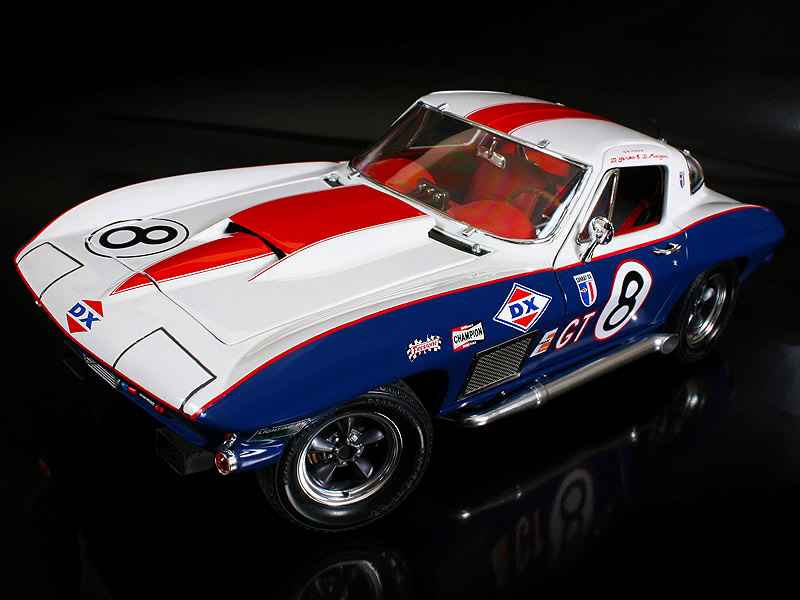1967 Chevrolet Corvette L88 Sunray DX
This 1967 L88 race car was up for auction with RM Auctions, Inc. on Saturday, August 17, 2002 at the Doubletree, Fisherman's Wharf, Monterey, CA. This L88 did not sell, but the high bid was $900,000! Below is the catalog description for this auction. Note: photos are copyright - Dave Friedman, RM Auctions.
Note: As per email to the Corvette Action Center by "Andy" on April 15, 2007:
"info update to tech center article re 67 DX vette: Bob Luebbe lived in central New York (Sherrill, NY) and not northern New York as stated in your article...Bob and I carpooled to work daily and I was 'boss wrench' on that and other Vettes that Bob raced...the '67 was offered to me for $2k when Bob moved up to the 68 DX car but I refused as it was ''obsolete''-- it had an aero prob at high speed that made the rear ''skittish'' and the 68 (doorhandles were modded to make that a 69) was stable at speed."
 Even before they could see its distinctive quad headlamps piercing the darkness, the Sunray DX Motorsports team knew when their Corvette was exiting the final ninety-degree turn at the end of Sebring's long back straight. Six hundred horsepower worth of big block Chevrolet generated a thunderous roar unlike anything else on the track.
Even before they could see its distinctive quad headlamps piercing the darkness, the Sunray DX Motorsports team knew when their Corvette was exiting the final ninety-degree turn at the end of Sebring's long back straight. Six hundred horsepower worth of big block Chevrolet generated a thunderous roar unlike anything else on the track.
This 16th annual running of the famed 12 Hours of Sebring, held April 1, 1967, marked the debut of Corvette's L88 option package. The aluminum headed 427, in concert with an M22 "Rock Crusher" transmission, heavy duty brakes and suspension, and a host of other competition inspired hardware, turned the Corvette into the purest race car to ever roll off a Detroit assembly line.
When the checkered flag fell at 10:00 p.m. the epic struggle of man and machine was over. In the hands of drivers Dave Morgan and Don Yenko, Sunray's L88 Corvette bested some of the world's greatest purpose built and production based racers to finish 1st in GT class and 10th overall.
The L88 engine that powered the red, white and blue DX racer to victory became a regular Corvette option soon after Sebring. As such, it was—and arguably remains—the most powerful engine ever offered in a true production car. That alone would ensure its place in history, but closer examination reveals much more to the L88 mystique than mere savage horsepower.
The introduction of the L88 package marked a monumental turning point in Chevrolet's on again, off again policy toward racing. Finally, the blue bow tie was in the game for real, bringing to fruition a legacy begun with the legendary small block V8 a decade and a half prior.
Led by Zora Arkus-Duntov, Chevy's Corvette engineering group began developing the L88, a thinly disguised all out race version of the Chevrolet Mark IV big block, early in 1965. Two years later all of the hardware for this ultra high performance engine was sorted and ready to go. Though derived from a regular production design, the L88 engine was much more than a beefed up version of the other 427s available in the late 1960s. As with any pure racing engine, its' real beauty could be found in the details. From its forged and Tuftrided crankshaft and 12.5:1 pistons, to its alloy cylinder heads and cold air induction system, this engine was designed to make maximum power while withstanding the rigors of round the clock endurance racing.
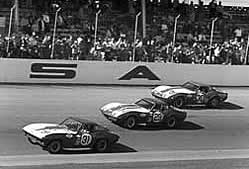 While the race bred 427 engine was the heart of the L88 option, it was actually just one component in a fully integrated package. Purchasers of the engine were required to also buy a long list of other competition components including an M22 "Rock Crusher" four-speed, F41 heavy-duty suspension, J50/J56 power assisted heavy-duty brakes, K66 transistor ignition, and G81 Positraction differential.
While the race bred 427 engine was the heart of the L88 option, it was actually just one component in a fully integrated package. Purchasers of the engine were required to also buy a long list of other competition components including an M22 "Rock Crusher" four-speed, F41 heavy-duty suspension, J50/J56 power assisted heavy-duty brakes, K66 transistor ignition, and G81 Positraction differential.
As equally important as what was required with the L88 option package was the list of equipment that could not be had with it. According to Chevy's in-house publication Corvette News, prohibition of luxury appointments and deletion of certain normally standard components was done to "cut down on weight and discourage the car's use on the street." Unnecessary items like air conditioning and a radio were forbidden, and normally important pieces such as the engine fan shroud, carburetor choke, and heater/defroster system were deleted. To further discourage the L88's use on the street, a warning sticker glued to the center console pointed out that the radically cammed, high compression engine required fuel with a research octane number of at least 103.
Just in case the L88's inability to cold start or its rough idle, ravenous fuel consumption, and total lack of creature comforts were not enough to dissuade street driving, the folks at Chevrolet devised a couple of more impediments. The first was the price. The engine alone added $947.90 to the bottom line and when all of the other, mandatory options were added in the price of the base car was increased by nearly 50%! If all else failed, the final deterrent was the L88's advertised power rating. It was quoted at 430 horsepower, five fewer than the L71 427/435 engine that cost less than half as much. Why would any buyer in his right mind pay more than twice as much for an engine that made fewer ponies? The answer of course is that he wouldn't, but did the L88 really make less power than the L71?
The L88's quoted output of 430 horsepower was measured at 4600 rpm, well below the engine's peak. Also, power was measured with cast iron exhaust manifolds and mufflers in place but the L88 craved an unrestricted exhaust path. Running through open exhaust on pure racing fuel and tuned to the razor's edge, the L88 could realize its true potential – almost 600 horsepower at 6,500 rpm!
In keeping with its true intended purpose, road racing on the world stage, the full L88 package was FIA homologated by the spring of 1967, just in time for that year's Sebring 12 Hour race. On March 9th, barely three weeks before Sebring, the first factory built L88 Corvette, the very car offered here, rolled out of the St. Louis Assembly Plant. The purchaser of this momentous Corvette was the Motorsports Division of Sunray DX Oil Corporation.
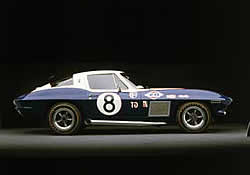 By 1965 Sunray DX was the sixth largest oil company in the world. It was also the oldest, with roots going all the way back to 1858. But in spite of its size and age the company was having some difficulty keeping pace with the rapidly changing socioeconomic landscape of the 1960s. After giving it careful consideration management realized that future growth depended on connecting with the exploding youth population. The postwar baby boomers who were then coming of age would, in a few short years, constitute a significant segment of their marketplace. But how to reach this group? The answer was simple, according to a small cadre of executives. The company needed to go racing. In so doing it could garner invaluable publicity and tap into young people's boundless enthusiasm for the horsepower war raging in Detroit. And what better way to sell high performance fuels and lubricants to America's youngsters than by racing a Corvette, Chevrolet's all-American sports car. To that end DX formed and alliance with Pittsburgh based Yenko Chevrolet, which was widely known and highly regarded for its ability to build and campaign racecars.
By 1965 Sunray DX was the sixth largest oil company in the world. It was also the oldest, with roots going all the way back to 1858. But in spite of its size and age the company was having some difficulty keeping pace with the rapidly changing socioeconomic landscape of the 1960s. After giving it careful consideration management realized that future growth depended on connecting with the exploding youth population. The postwar baby boomers who were then coming of age would, in a few short years, constitute a significant segment of their marketplace. But how to reach this group? The answer was simple, according to a small cadre of executives. The company needed to go racing. In so doing it could garner invaluable publicity and tap into young people's boundless enthusiasm for the horsepower war raging in Detroit. And what better way to sell high performance fuels and lubricants to America's youngsters than by racing a Corvette, Chevrolet's all-American sports car. To that end DX formed and alliance with Pittsburgh based Yenko Chevrolet, which was widely known and highly regarded for its ability to build and campaign racecars.
Don Yenko was an SCCA national champion and both he and his father Frank counted among their close personal friends such influential people as the aforementioned Zora Duntov, Corvette Chief Engineer, and Ed Cole, president of General Motors. Those connections to the powers that be at GM were crucial because the L88 would not be released for production until after Sebring. Managers at DX understandably wanted to compete at this important race and would therefore need their L88 immediately. Don Yenko was probably the only Chevrolet dealer in the world who could pick up his telephone and call the president of GM at home to ask for a personal favor. He made the call and Ed Cole issued the necessary edict. As was standard procedure when a car that did not conform to regular production parameters was approved, a Chevrolet Central Office Production Order (COPO for short) was issued. The progeny of that COPO, the L88 Corvette offered here, would go on to lead a storied and glorious life.
Well known mid-west area road racer and frequent Sebring competitor Dave Morgan traveled to the St. Louis Corvette Assembly plant to take immediate delivery of the car when it was completed on March 9th. "They were just finishing up when I got there," he recalls, "and I watched it fail the water test at the end of the assembly line. It was built several hundred pounds lighter than a regular Corvette and the leak test people didn't realize all of the body putty and sealant had been left out to save weight!" The vulnerability to water penetration notwithstanding, and suffering somewhat from the absence of a heater in early March, Morgan drove the beast from St. Louis to Yenko's facility in Canonsburg, Pennsylvania where it was immediately disassembled and race prepared.
Three weeks later the car took its place on the starting grid for the 12 Hours of Sebring. Morgan and Don Yenko co-drove the car at Sebring, finishing first in GT class and tenth overall despite spending the final forty minutes of the race perched on a sand bank after brake failure going into the hairpin. Morgan campaigned the car solo for the remainder of 1967, taking home the SCCA mid-west division title for his efforts.
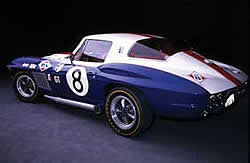 Besides its racing duties, in 1967 and continuing into '68 the car was used extensively as a test bed for other Corvettes raced under the DX banner and for retail product development. In the thirtysix states where their products were sold Sunray's line of Supersport lubricants and high octane fuel was the most visible result of this ongoing field testing and development work.
Besides its racing duties, in 1967 and continuing into '68 the car was used extensively as a test bed for other Corvettes raced under the DX banner and for retail product development. In the thirtysix states where their products were sold Sunray's line of Supersport lubricants and high octane fuel was the most visible result of this ongoing field testing and development work.
Some of the more notable names who drove the Corvette in 1968 include Peter Revson, Pedro Rodriguez, Bob Bondurant, Dick Guldstrand, and Jerry Grant. The most significant outing for the car in that year came at the Daytona 24 Hour race, where Grant and Morgan co-drove to a first in class, tenth overall finish. The car ran perfectly at Daytona for the entire 24 hours and, assisted by special differential gearing provided by Chevrolet Engineering and centrifugal forces generated by the superspeedway's severe banking, achieved speeds in excess of 194 mph.
Remembering the DX L88's impressive durability and incredible speed potential Morgan recently had this to say; "That was one of the most reliable race cars I've ever driven. It was a fine car that did everything well. It handled, it stopped, and it went like hell! We hit 194 mph at Daytona and ran the entire 24 hours without a single mechanical problem. The engineers really did their homework and it showed out on the track." Plans were put in place to expand the DX Motorsports program in 1969, including an entry at Le Mans, but it never came to fruition.
Toward the end of 1968 Sunray DX finalized a merger deal with Philadelphia based Sun Oil and Pipeline Company. Sun Oil, better known as Sunoco, already had a very active racing program courtesy of Roger Penske and company so Sunray's endeavors were deemed duplicative and unnecessary.
In August of 1969 Sunray's 1967 Corvette was sold to a northern New York engineer named Bob Luebbe via an advertisement in Competition Press. Luebbe campaigned the car through 1971, his greatest success a class victory at the Watkins Glen Six-Hour contest. Luebbe sold the L88 to friend and fellow engineer Dave Laughlin, who raced it through 1973, which is when he sold it to Tom Rynone. Rynone campaigned the car one year, selling it to Long Islander Dave Dempsey in August 1974. Dempsey continued to use the car exclusively for racing until 1987, when he began street driving it in addition to competing in it.
Before taking it onto the street in '87 Dempsey walked into a New York State DMV office to register it for the very first time. The clerks in the motor vehicle office had never seen a twenty year old car that went untitled from new and was still on MSO and had also never seen an SCCA log book, which is what Dempsey brought along to evidence ownership. They were willing to register the car but wanted to keep the log book in exchange for a current registration. Fortunately, Dempsey thought it prudent to retain the log book and refused to relinquish it, a demand the DMV clerk finally acquiesced to.
 The present owners of this remarkable L88 purchased it from Dave Dempsey in 1990 and immediately set about restoring the car back to its 1967 Sebring configuration. The original body was removed from the original chassis and the ravages of twentythree years of uninterrupted competition were painstakingly repaired. Every single component was functionally and cosmetically restored to new condition. Numbered and dated assemblies including the engine and transmission are correct for the car. All of the rare L88 package parts, including closed chamber aluminum cylinder heads, oversize aluminum radiator, cold air induction hood, heater/defroster delete plates, and special road draft tube are correct. All of the car's unusual COPO components, including its unique exhaust system, battery mounting system, dual-pin rear calipers, American Racing wheels, and offset rear trailing arms are also correct. In the interests of safety and vintage race eligibility the original 44 gallon fuel tank was replaced with an identical size modern fuel cell and carbon composite brake pads took the place of the original metallic pads.
The present owners of this remarkable L88 purchased it from Dave Dempsey in 1990 and immediately set about restoring the car back to its 1967 Sebring configuration. The original body was removed from the original chassis and the ravages of twentythree years of uninterrupted competition were painstakingly repaired. Every single component was functionally and cosmetically restored to new condition. Numbered and dated assemblies including the engine and transmission are correct for the car. All of the rare L88 package parts, including closed chamber aluminum cylinder heads, oversize aluminum radiator, cold air induction hood, heater/defroster delete plates, and special road draft tube are correct. All of the car's unusual COPO components, including its unique exhaust system, battery mounting system, dual-pin rear calipers, American Racing wheels, and offset rear trailing arms are also correct. In the interests of safety and vintage race eligibility the original 44 gallon fuel tank was replaced with an identical size modern fuel cell and carbon composite brake pads took the place of the original metallic pads.
Concurrent with restoring the car, the present owners expended tremendous time and energy exhaustively documenting its history. They have traveled all over the country visiting each prior owner and every venue that bears some connection to the car including the former Yenko dealership and Yenko family homestead outside of Pittsburgh, Sunray's headquarters in Tulsa, and even the Eisenhower Memorial Library in Kansas, which houses the papers of a former Sunray executive who also served in Ike's administration. In the process they have amassed an impressive collection of photographs and paperwork that meticulously and thoroughly documents this rarest of all production Corvettes. The photographic log begins when the car was brand new and progresses through its racing history and restoration right up until the present. Original paperwork includes the car's dealer invoice and subsequent bills of sale, SCCA log book, Chevrolet Engineering papers, General Motors documents carrying its unique COPO invoice number, and FIA homologation papers. Since undergoing restoration the DX L88 has been driven 2,200 miles on the street and has participated in a number of vintage events. The most notable of these include the 1994 Pittsburgh Vintage Grand Prix and the 1999 Legends of Daytona Invitational. It was driven at the former by Dr. Dick Thompson, the incomparable "Flying Dentist", and at the latter by Dave Morgan, the very same Dave Morgan who drove it to victory at Daytona thirty-one years prior. In addition to its on-track activities, the car has appeared in the Bloomington Gold Special Collection, in a special display at the Chevrolet Technical Center in Warren, Michigan, and in GM's Corvette racing heritage displays at both the SEMA show in Las Vegas and at Daytona International Speedway.
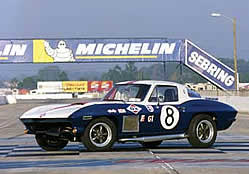 In 1992 it was brought back to Canonsburg for a reunion party with Yenko family members, former Yenko Chevrolet employees, and others connected with the car's early history.
In 1992 it was brought back to Canonsburg for a reunion party with Yenko family members, former Yenko Chevrolet employees, and others connected with the car's early history.
The L88 option disappeared from Corvette order sheets soon after it appeared, falling victim to increasingly stringent safety and emissions standards as well as a changing socio-political climate. When it was over a total of 20 1967 L88 Corvettes had been built. Though few in number, they wielded great and lasting influence everywhere they were called upon to compete. From the high banks of Daytona to the Bonneville Salt Flats, from the medieval city of Le Mans to a World War II airbase in Sebring, Florida, and from National Speedway to Main Street USA, L88 Corvettes emerged triumphant and forged a legendary reputation for unsurpassed performance. The handful that survive to this day are poignant reminders of a distant past, an era when anybody with enough gumption and enough money could walk into any Chevrolet dealer in the nation and buy the fastest, most powerful production car the world had ever known.
As Corvette racing cars go, Grand Sports are undoubtedly the most well-known however valued in excess of $3,000,000 USD, and with only limited international success they make the L88 offered here, with its GT Class wins at Sebring and Daytona, a historically more successful and compartitively attractively priced American racing car. Of the twenty L88s sold in 1967 fewer than ten documented examples remain.
The Sebring and Daytona winning Sunray DXL88 offered here is by far the most important L88 in existence, and to many is the most desirable production Corvette ever made. With a continuous history from new, thorough documentation, two exemplary race performances at the most demanding races in North America, Sebring and Daytona, an SCCA Divisional Championship, a history of great drivers and a fastidious restoration to its 1967 Sebring configuration, it comprises an incomparably important chapter in Corvette's fifty year history.
This is the first time the car has been offered publicly since it was advertised by Sunray DX Oil Company in Competition Press thirty-three years ago, and as such represents a rare opportunity to acquire a unique Corvette that is without peer in every regard.
